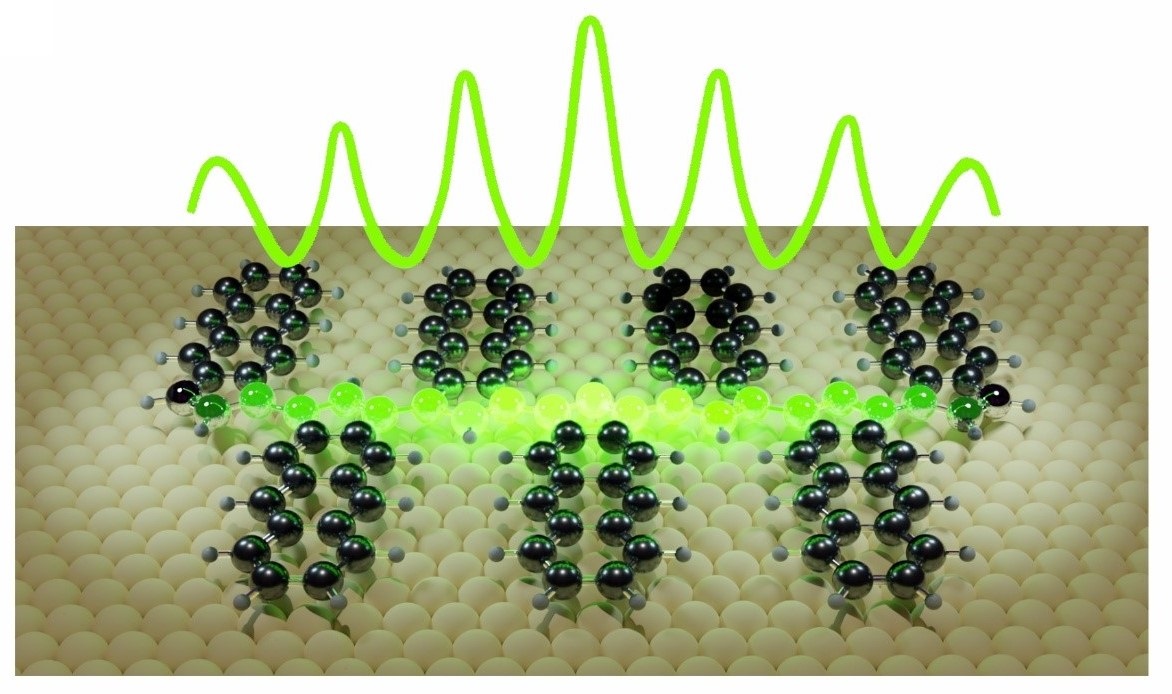A novel chemical reaction on a surface enables the emergence of solitons in π-conjugated polymers
16.10.2024
 |
|
Delocalization of a soliton along an odd-member π-conjugated polymer on Au(111). Credit: José I. Urgel. |
- Researchers demonstrate that the design of potentially highly conducting polymers avoiding doping is feasible.
- The novel chemical reaction on a surface reveals that structural parity drives the emergence of solitons in π-conjugated polymers.
| Tweet |
Madrid, 16th October, 2024. π-conjugated polymers are a class of macromolecules featuring an alternation of single and double bonds along their backbone, which enables delocalized π-electrons. Their unique electronic structure makes them highly conductive and very attractive for applications such as solar cells or light-emitting diodes. To enhance their electronic properties, π-conjugated polymers are often doped. However, the structure and stability of the polymer suffers.
In a new study, researchers introduce an unprecedented reaction, coined indenyl coupling, to design highly conducting carbon-based polymers. They demonstrated the possibility to bond indane-based monomers in an extremely selective and efficient way on a metallic surface affording the design of π-conjugated polymers. Remarkably, the researchers exploited the structural parity of the polymers to afford the emergence of in-gap soliton states, which spatially extend several nanometers along the longitudinal backbone.
The results, recently published in Nature Synthesis, answer a fundamental question in materials science: Is it possible to experimentally synthetize potentially highly conducting polymers without the need of external doping? The authors demonstrate that theoretical predicted concepts of structural parity can be an essential factor to consider when designing tailored nanomaterials hosting topological quasiparticles. This approach could lead to more efficient, cost-effective, and sustainable electronic devices featuring 1D wires.
This work is the result of a collaboration between physicists and chemists at the Madrid Institute for Advanced Studies in Nanoscience (IMDEA Nanociencia), Centro Singular de Investigación en Química Biolóxica e Materiais Moleculares (CiQUS), Universidade de Santiago de Compostela, the Institute of Physics of the Czech Academy of Science and Instituto de Ciencia de Materiales de Madrid (ICMM-CSIC) and is partially funded by the accreditation Excellence Severo Ochoa awarded to IMDEA Nanociencia (CEX2020-001039-S) and by the accreditation Centro de Investigación de Galicia awarded to CiQUS (ED431G 2019/03).
Glossary:
- π-conjugated polymers: Linear molecules featuring an alternation of single and double bonds along their backbone, which enables delocalized electrons.
- Soliton: a localized wave packet (quasiparticle) that preserves its shape while propagating freely in a nonlinear medium.
Reference:
Kalyan Biswas, Jesús Janeiro, Aurelio Gallardo, Marco Lozano, Ana Barragán, Berta Álvarez, Diego Soler-Polo, Oleksandr Stetsovych, Andrés Pinar Solé, Koen Lauwaet, José M. Gallego, Dolores Pérez, Rodolfo Miranda, José I. Urgel*, Pavel Jelínek*, Diego Peña* and David Écija*. Designing highly delocalized solitons by harnessing the structural parity of π-conjugated polymers. Nature Synthesis (2024). DOI: 10.1038/s44160-024-00665-8
![]() https://repositorio.imdeananociencia.org/handle/20.500.12614/3807
https://repositorio.imdeananociencia.org/handle/20.500.12614/3807
Contact:
José Ignacio Urgel
Jose-ignacio.urgel (at)imdea.org
https://nanociencia.imdea.org/on-surface-synthesis-of-carbon-based-nanostructures/home
https://scanlab.es
Twitter: @nacho_urgel
Diego Peña
This email address is being protected from spambots. You need JavaScript enabled to view it.
https://www.usc.es/ciqus/es/grupos/commo
Twitter: @depena33
David Écija
david.ecija (at)imdea.org
https://nanociencia.imdea.org/nanoarchitectonics-on-surfaces/group-home
Twitter: @davidecijalab
Oficina de Divulgación y Comunicación en IMDEA Nanociencia
divulgacion.nanociencia [at]imdea.org
Twitter: @imdea_nano
Facebook: @imdeananociencia
Instagram: @imdeananociencia
Source: IMDEA Nanociencia y CiQUS.




